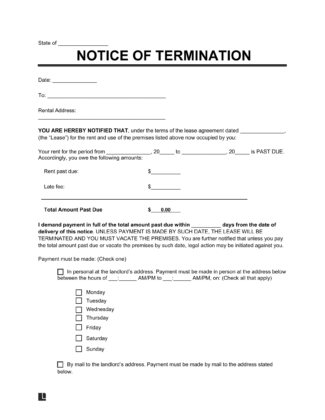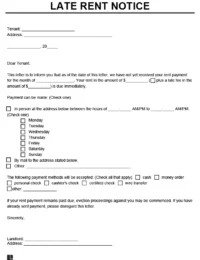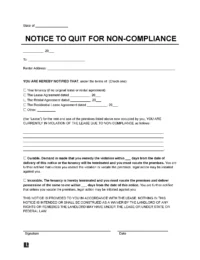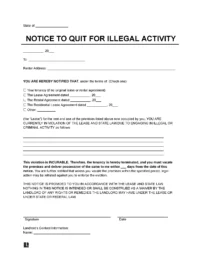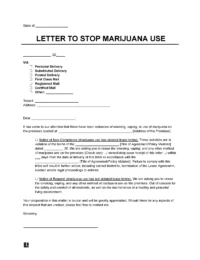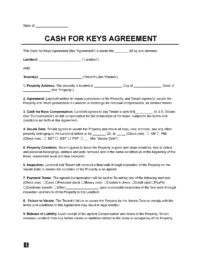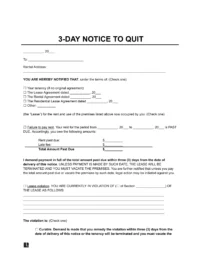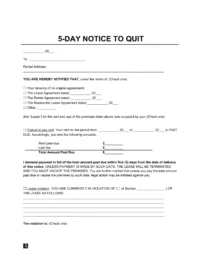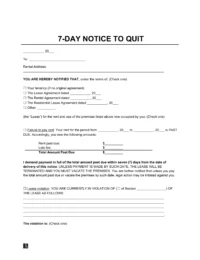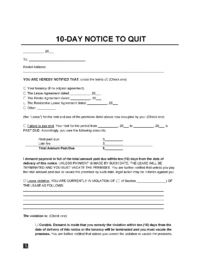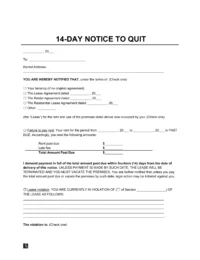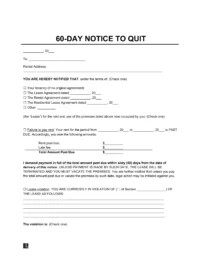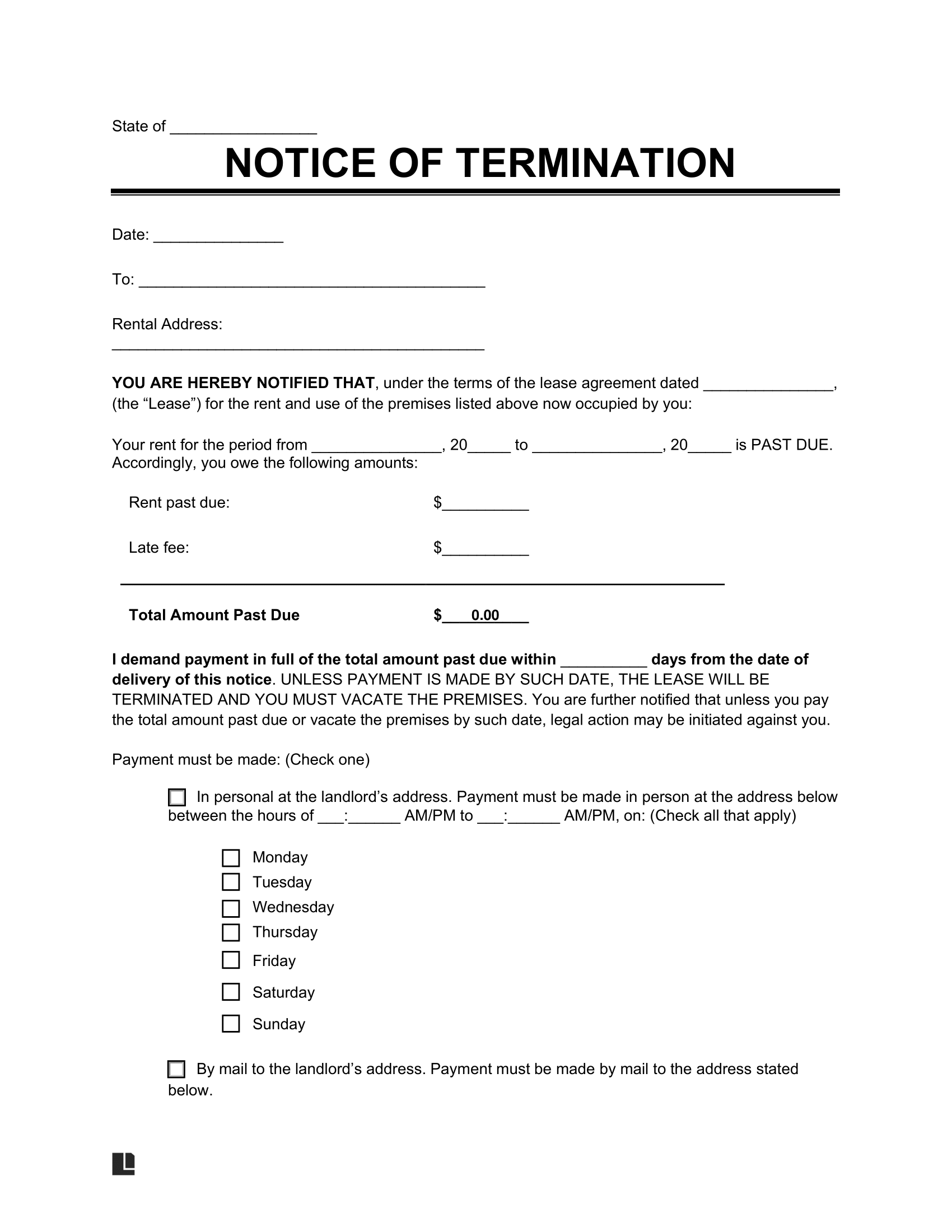An Eviction Notice is a letter a landlord sends to tenants to inform them that they must fix a particular problem or vacate the property within a certain number of days.
Landlords generally send eviction notices if tenants fail to pay rent, but they also use them if they violate the lease agreement’s terms.
Alternative Templates
If you are a tenant who needs to let your landlord know you want to move out, consider sending a Notice to Vacate.
By State
- Alabama
- Alaska
- Arizona
- Arkansas
- California
- Colorado
- Connecticut
- Delaware
- District of Columbia
- Florida
- Georgia
- Hawaii
- Idaho
- Illinois
- Indiana
- Iowa
- Kansas
- Kentucky
- Louisiana
- Maine
- Maryland
- Massachusetts
- Michigan
- Minnesota
- Mississippi
- Missouri
- Montana
- Nebraska
- Nevada
- New Hampshire
- New Jersey
- New Mexico
- New York
- North Carolina
- North Dakota
- Ohio
- Oklahoma
- Oregon
- Pennsylvania
- Rhode Island
- South Carolina
- South Dakota
- Tennessee
- Texas
- Utah
- Vermont
- Virginia
- Washington
- West Virginia
- Wisconsin
- Wyoming
By Reason/Action
Notice to Pay or Quit (Non-Payment)
Use it to let a tenant know rent is late and encourage them to pay.
Notice to Comply or Quit (Non-Compliance)
Sent by a landlord when a tenant commits a lease violation other than late rent.
Notice to Quit for Illegal Activity
Informs the tenant they must vacate the property because they committed an unlawful act.
Warning Letter for Smoking Marijuana
Warns a tenant to stop smoking marijuana and states the consequences if they fail to do so.
Cash-for-Keys Agreement
Creates an agreement where the tenant receives a cash payment if they voluntarily vacate the property.
By Number of Days
Grants the tenant a seven-day window to address the violation; failure to comply or vacate may prompt eviction proceedings.
7-Day
Notifies a tenant of overdue payments or lease agreement violations, allowing them the option to rectify the situation or vacate the premises within ten days.
10-Day
Allows a tenant to rectify a lease violation or vacate the property. Repeated breaches within a specified period may grant the landlord the option to terminate the agreement.
14-Day
- By State
- By Reason/Action
- By Number of Days
- What is an Eviction Notice?
- Eviction Notice Example
- Notice Periods & Laws - By State
- Types of Eviction Notices
- What is the Eviction Process?
- What Should You Include in an Eviction Notice?
- Sample Eviction Notice
- How to Write an Eviction Notice
- Frequently Asked Questions
What is an Eviction Notice?
An eviction notice ( or an eviction letter ) is a legal document used by a landlord to evict a tenant for not complying with the original terms of the lease or rental agreement.
In some cases, the landlord may believe the problem is not fixable and send what’s known as an incurable eviction notice. In the case of an incurable eviction notice, the tenant has no choice but to vacate the property within a certain number of days.
Even if the landlord serves an eviction notice, the tenant has the right to stay on the premises until a judge hears from the landlord and tenant.
IMPORTANT
A landlord needs a court order before evicting a tenant. Suppose tenants do not voluntarily vacate or move out. In that case, a sheriff or other law enforcement officer may forcibly remove them and their belongings even after the judge issues an official court order.
What is the Difference Between a “Tenant at Will” and a “Tenant at Sufferance”?
Most states give a “Tenant at Will” more protection than a “Tenant at Sufferance.”
A tenant usually stays on the premises with the landlord’s permission, so states often give such tenants more advanced notice (i.e., 30-day notice).
In contrast, a tenant at sufferance (i.e., a holdover tenant) stays on the premises without the landlord’s permission and gets less time for a landlord to begin an eviction (i.e., usually, no advanced notice is required).
Here’s an easy-to-understand chart describing the differences:
Tenant at Will vs. Tenant at Sufferance
| Tenant at Will | Tenant at Sufferance |
|---|---|
| Landlord permission given | Landlord does NOT give permission |
| Month-to-month lease (written or verbal) | Landlord ends month-to-month lease |
| Invalid lease (i.e. no rent amount) | Landlord sends a Notice to Quit |
| Written lease ended or expired BUT 1. Landlord accepts your rent 2. No new lease has been signed | Written lease ended or expired and 1. Landlord wants Tenant out 2. Landlord does not accept rent or accept rent under protest (AKA "Holdover Tenant") |
| No expiration date or last day of rent |
Eviction Notice Example
The following eviction notice example is a record of a notification given by the landlord, ‘Sarah R Cooper,’ to the tenant, ‘Margaret A Burgess.’ Sarah R Cooper wishes to inform Margaret A Burgess that the lease is terminated and that Margaret needs to leave the premises.
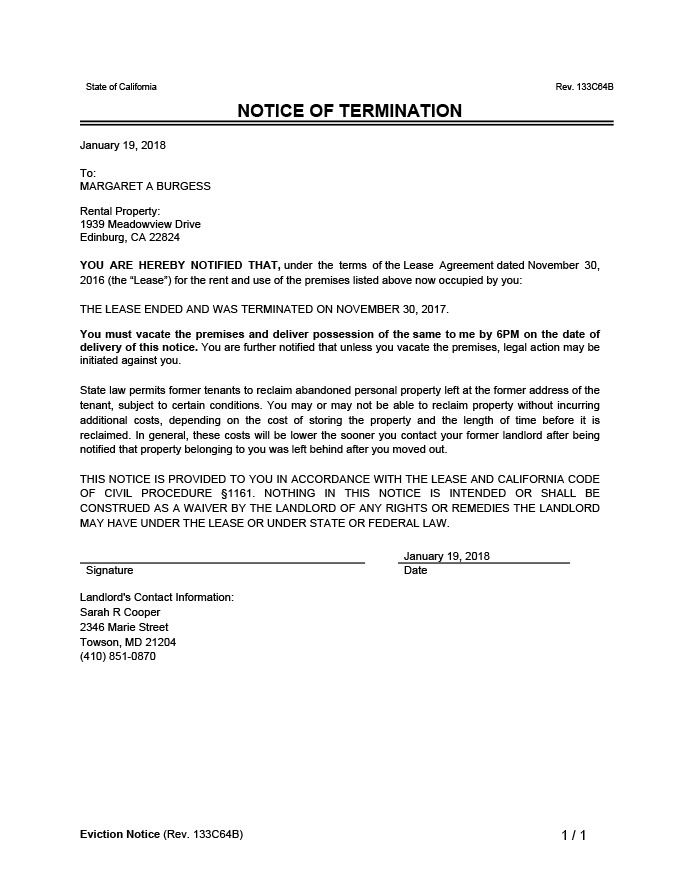
If you wish to send your tenant an eviction notice for a different reason or to save time, use our document builder to create your eviction notice online.
Our state-specific eviction notice templates let you easily create a customized eviction notice (with step-by-step instructions) to send to your tenant.
Notice Periods & Laws – By State
Use the table below to find out which type of notice you need to provide based on state-specific applicable periods and laws:
| State | Notice Period - Non-Payment | Notice Period - Non- Compliance | Pay to Avoid Eviction ( if curable ) | Law |
|---|---|---|---|---|
| Alabama | 7 days | 7 days | Yes | § 35-9A-421 |
| Alaska | 7 days | 10 days | Yes | § 34-3-160, § 34-3-220 |
| Arizona | 5 days | 10 days | Yes | § 33-1368 |
| Arkansas | 3 days | 14 days | No | § 18-60-304, § 18-17-901 |
| California | 3 days | 3 days | Yes | Code of Civil Procedure 1161 |
Types of Eviction Notices
As a reference, there are three kinds of notices:
1. Pay Rent or Quit Notices (“Failure to Pay Rent”)
The tenant has 3 to 5 days (check your local housing laws) to pay rent or leave.
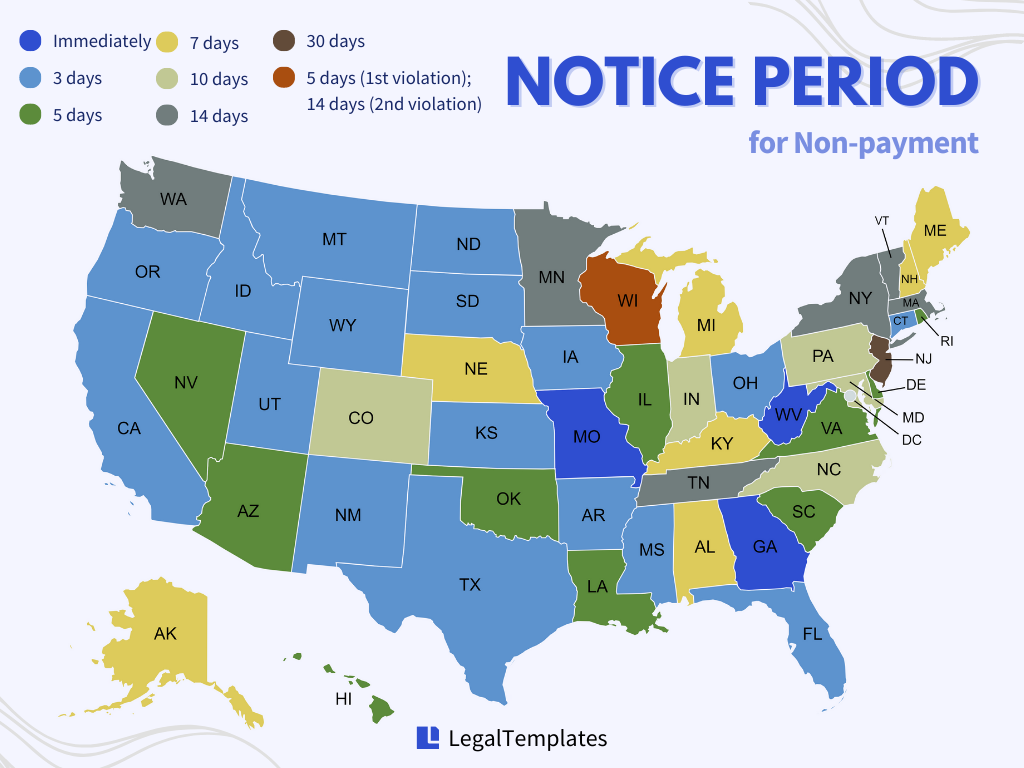
Most state eviction laws agree that tenants should pay their rent on time. More than a third of the states require landlords to give a minimum 3-day eviction notice when rent is late or overdue, while almost a quarter of the states require a minimum of 5 days, and only six states require seven days.
2. Cure or Quit Notices (“Lease Violation”)
Tenants have a certain amount of time to correct or “cure” a problem like violating a no-smoking or no-pet policy. Otherwise, they must leave or “quit” the premises.
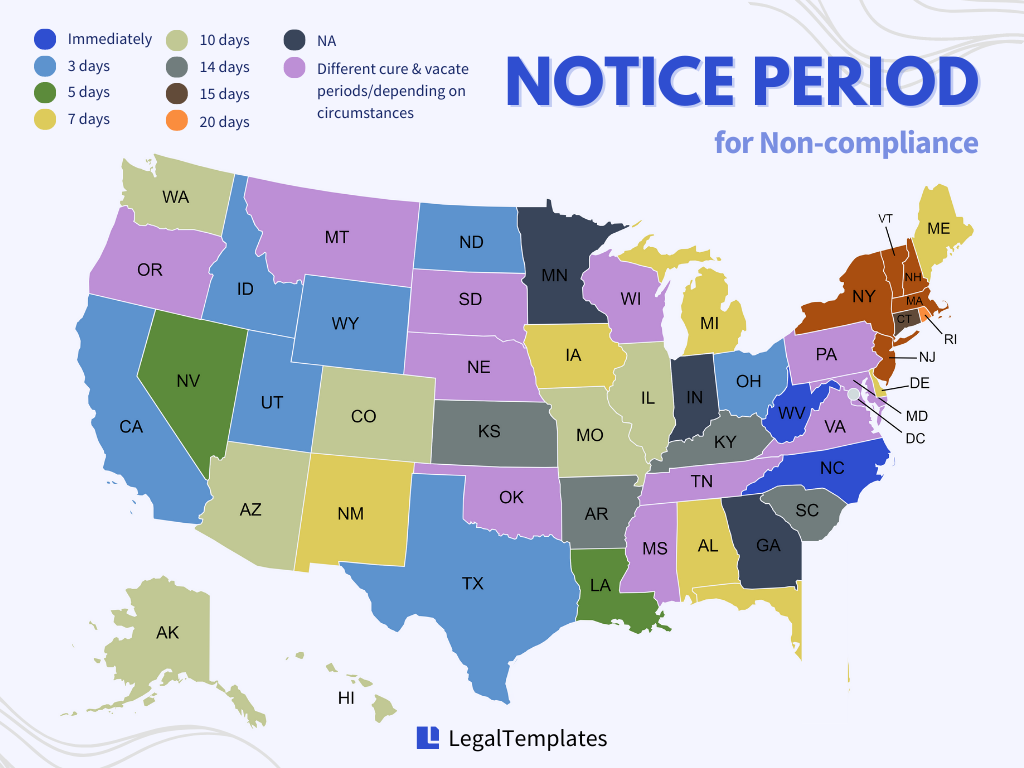
States vary widely on the minimum number of days a landlord should give tenants to cure the default (i.e., no longer violate the lease provision).
If a tenant has broken one of their promises in the lease agreement, nine states require that landlords give tenants a minimum 3-day eviction notice.
Interestingly, eight states do not require a minimum notice since the lease already spells out the obligations, and the tenant is perhaps assumed to have broken the lease knowingly.
3. Unconditional Quit Notices (End “Month-to-Month”)
The tenant cannot pay rent or correct the problem because, on multiple occasions, they have:
- failed to pay rent on time
- violated the lease agreement
- seriously damaged (or is currently damaging) the premises
- committed a crime on the premises (like selling drugs or running a prostitution business)
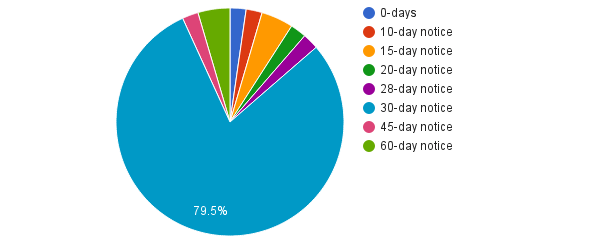
Most states (more than ⅔) require only a 30-day eviction notice to end a month-to-month or holdover tenancy, but some states, like Delaware and Georgia, provide a more tenant-friendly 60-day notice.
Landlords also use unconditional quit notices to end an unwanted landlord-tenant relationship with someone who has overstayed their lease (i.e., a Tenant at Sufferance).
What is the Eviction Process?
Generally, the rules and regulations governing the process provide different protections for landlord and tenant due process. Neither the tenant nor the landlord can be deprived of “property” in the form of either housing (for the tenant) or rent money (for the landlord), following appropriate legal procedures and safeguards.
The eviction process is akin to an expedited lawsuit by the landlord (i.e., plaintiff) against the tenant (i.e., defendant). It ensures that both the tenant and the landlord receive fair treatment. Only the judge has the final say in whether the tenant must leave.
Other ways to refer to the eviction process include:
- Ejectment
- Eviction lawsuit
- Forcible detainer
- Repossession
- Summary process
- Summary possession
- Unlawful detainer action (UDA or UD)
Usually, the eviction process is a “summary” court procedure. This means that the court will move forward with the case quickly, and the tenant has a short time to respond to the lawsuit.
Instead of waiting months for a judge to hear the case, the landlord and tenant can appear before the local court relatively soon after the landlord files a complaint.
When Do You Need an Eviction Notice?
Landlords use an eviction notice to inform tenants of the beginning of the eviction process. Still, landlords may not need to begin eviction if the landlord and tenant can resolve the problem by themselves.
It is desirable in most cases to avoid serving an eviction notice to save both parties time, energy, and expense.
The following are some possible reasons for eviction:
- The tenant has failed to pay rent. If the tenant has not paid rent, the landlord can use the eviction notice to notify the tenant to pay the due rent. If the tenant does not pay rent by a specific date, the tenant must leave the premises.
- The tenant has violated the lease agreement. If the tenant has violated the lease agreement, the landlord can use the eviction notice to notify the tenant to leave the premises by a specific date. Sometimes, the tenant can remedy or correct the violation by a particular time to avoid eviction.
- I wish to terminate a month-to-month tenancy. If the current agreement is a month-to-month rental arrangement, the landlord can use the eviction notice to notify the tenant that their month-to-month tenancy will end by a specific date.
- The lease has ended, and the tenant has remained on the property (holdover). If the tenant has stayed on the property past their lease end date, the landlord can use this eviction notice to notify the tenant that they must leave the premises.
If the tenant is late paying rent, there are several procedures a landlord can follow.
Perhaps there was a misunderstanding about the lease terms — did the tenant have a death in the family, suffer a work injury, or lose their job? Maybe the landlord is willing to work out a payment plan for missed rent payments. Would the tenant be willing to pay for the cost of repair to fix the damage caused to the premises?
Sometimes, a sincere apology, candid communication, and an honest willingness to cooperate can save the landlord and tenant time and money in the long term.
If landlords and tenants cannot resolve a disagreement, and landlords want to end the lease agreement and properly ask tenants to leave by a specific date, they should send an eviction notice.
IMPORTANT
In the hurry to voluntarily move out, a tenant might also leave furniture and personal belongings. Before landlords sell these abandoned personal items, they should check local and state laws.
Some states require landlords to store abandoned belongings for a specific time.
In contrast, others allow landlords to sell these items, but only after contacting the tenant, posting a notice in the newspaper, or following other strict procedures.
How to file an Eviction
If a landlord doesn’t follow the proper procedures, the tenant can challenge the eviction on a technicality and force the landlord to restart the process.
For example, if the landlord was required to give a 10-day notice but only gave a 3-day notice, the tenant may be able to claim that you violated their right to due process.
A landlord should consult their local housing laws and carefully follow the strict steps to evict a tenant properly.
It’s my house! Can’t I kick out a bad tenant?
Even if a tenant may be actively damaging the premises, a landlord may NOT resort to self-help measures. Instead, the court will require the tenant to move out sooner if the landlord is right. In most states, self-help measures are ILLEGAL.
A landlord may NOT:
- Change the locks
- Put padlocks on the door
- Remove outside doors or windows
- Shut off the lights, gas, or water
- Move out the tenant’s furniture
- Intimidate or harass the tenant to move out
- Physically remove the tenant (i.e., Uncle Vinny can NOT help you)
The landlord MUST use the court-administered eviction process to remove the tenant from the premises.
Ultimately, only the courts have the power and authority to decide whether an eviction can legally occur.
What Should a Landlord Include in an Eviction Notice?
When thinking about how to write an eviction notice, remember that the document should answer: Who, Why, Where, What, and When
Who does the eviction notice apply to
- The tenant’s name and address
- The landlord’s name and address
Why there is the reason for an eviction
- Failure to Pay Rent
- Lease Violation
- Month to Month Tenancy Ended
- Lease Expired (i.e., Holdover Tenant)
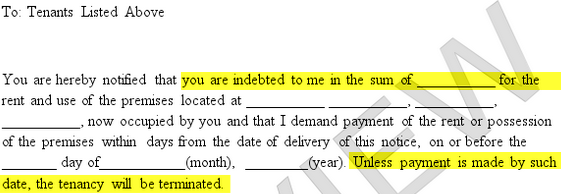
Where the eviction occurs
- The “Address” or the “Premises:”
This is the address and location of the rental property (or “Premises”) from which the landlord is evicting the tenant. Be sure to include any room or apartment number as part of the street address if it applies to your type of housing.

What should be done to fix the problem
- The name and date of the original lease agreement
- A reference to the lease about how the tenant can fulfill their promise
When the tenant must remedy the situation
- The notice is in effect (the “Notice Date”)
- The tenant must pay rent or leave the premises by a specific date (“Deadline”)

Sample Eviction Notice
The following downloadable eviction notice is a sample of what to use when your tenant fails to pay rent (also known as a notice to pay rent or quit).
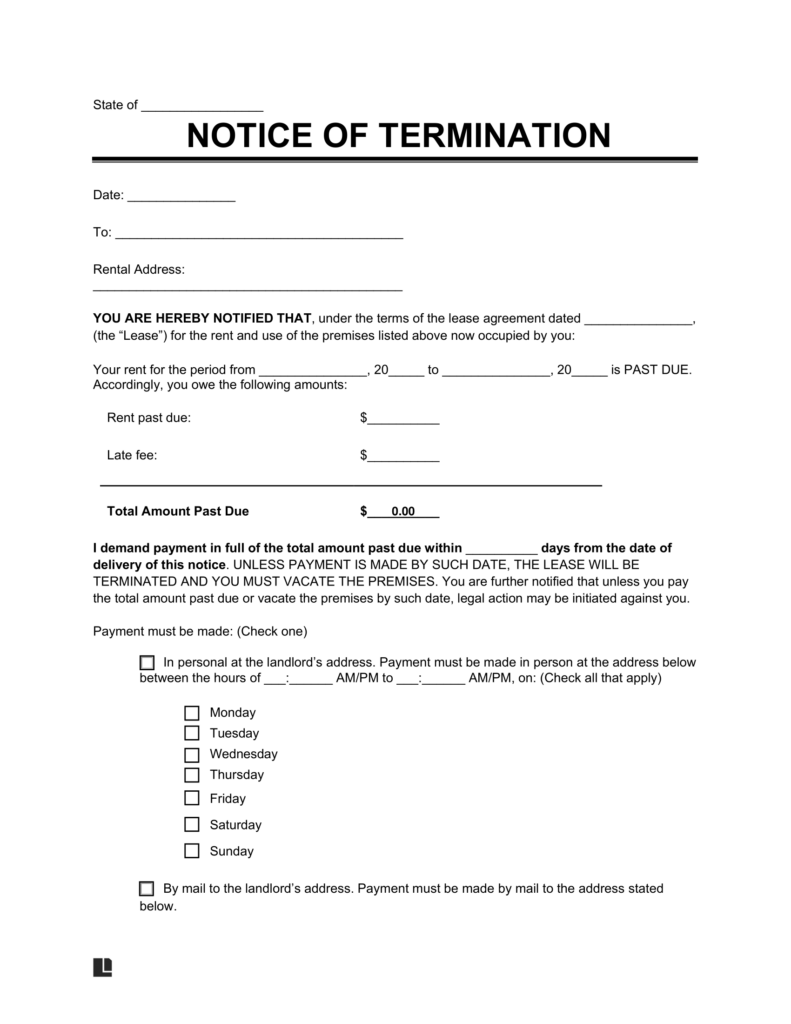
How to Write an Eviction Notice
Before you fill out your notice of termination, enter the state where you will start the eviction process.
Step 1 – Fill Out Tenant Information and Property Address
1. Tenant Name. Provide the names of all tenants that entered into the original lease agreement.
2. Property Details. Enter the complete street address for the rental property, including the unit/apartment/room number, if applicable. This is the physical location from which you are evicting the tenant.

Step 2 – Enter the Lease Agreement and Late Rent Details
3. Name of Original Agreement. Write the name/title of the original agreement between the tenant and landlord, such as a Lease Agreement, Rental Agreement, or Residential Lease Agreement.
4. Date of Original Agreement. Fill out the date of the original lease agreement (the date the landlord and tenant entered the contract).
IMPORTANT
Our eviction notice covers four types of evictions: failure to pay rent, tenant violation of lease agreement, holdover tenant (after lease expiration), and terminating a periodic tenancy. This example is for failure to pay rent, which is probably the most common.
5. Past Due Rent Dates. Provide the start and end dates for the period the rent is past due.
6. Past Due Rent Amount. Write the amount of money for past due rent that the tenant owes the landlord.
7. Total Late Fees. Enter the number of late fees (due to past due rent) the tenant owes the landlord. The original lease agreement should address the calculation of late fees. Remember that state laws regulate late fees and may limit the amount a landlord can charge a tenant for late rent; for example, late fees cannot exceed 5% of the rent due in some states.

Step 3 – Tell the Tenant How to Pay the Late Rent
8. Date to Pay Past Due Rent. Explain the number of days the tenant has to pay the amount past due or face eviction. The number of days the tenant must pay depends on the state your property is located in (for example, three or five days’ notice.) If the tenant does not pay within that time frame, you can terminate the tenancy, and the tenant must leave the property.
9. How to Pay Past Due Rent. Select one of the methods that are acceptable to receive the past due rent payment.
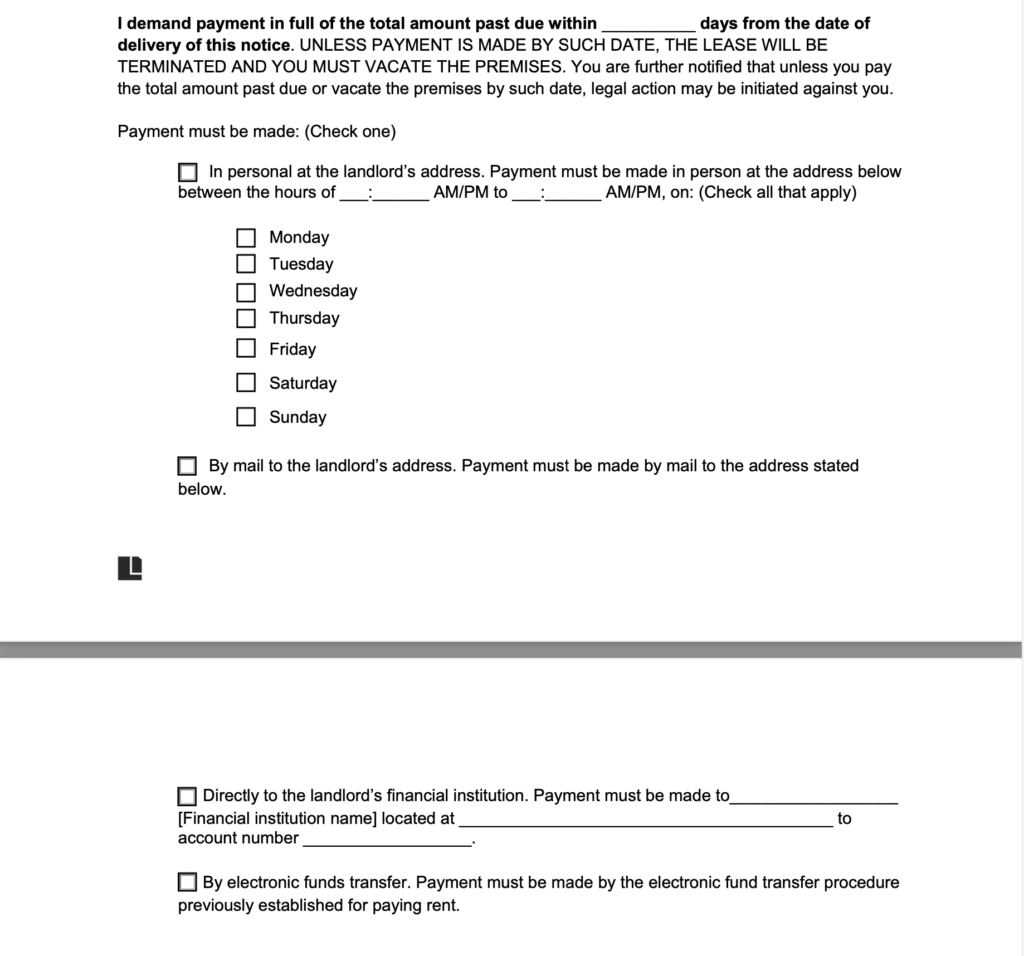
Step 4 – Reference State Statues and Sign Notice
10. Notice Provided in Accordance with State Statute. Our builder will populate the applicable state law/regulation name and section number depending on your property’s location.
11. Landlord Name and Date of Signature. Sign and date this notice.
12. Landlord Contact Information. Provide the most current information so the tenant can contact the landlord if necessary.
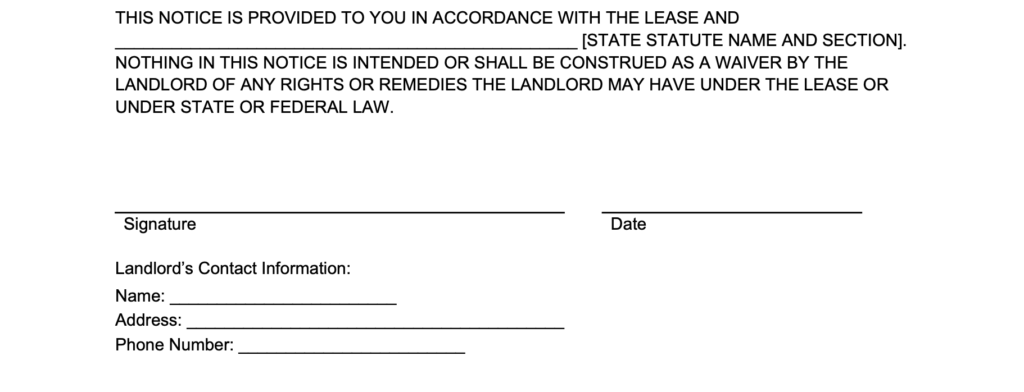
Step 5 – Provide Proof of Service Information
Proof of service is an affidavit, signed under oath, that acts as proof that the Eviction Notice/Notice of Termination was served to the Tenant.
13. Date of Delivery. Enter the date of delivery. This is important because it provides evidence of the date the notice is delivered to the tenant, which starts the number of days the tenant has to pay the past due rent.
14. Method of Delivery. Choose a method of delivery. Personal hand delivery to the tenant is one of the best and most direct methods. Delivery to someone other than the tenant is acceptable if the server is confident the recipient will reliably give the notice to the tenant. The server should complete the fields for the person receiving the notice and the address of the location where the notice was delivered.
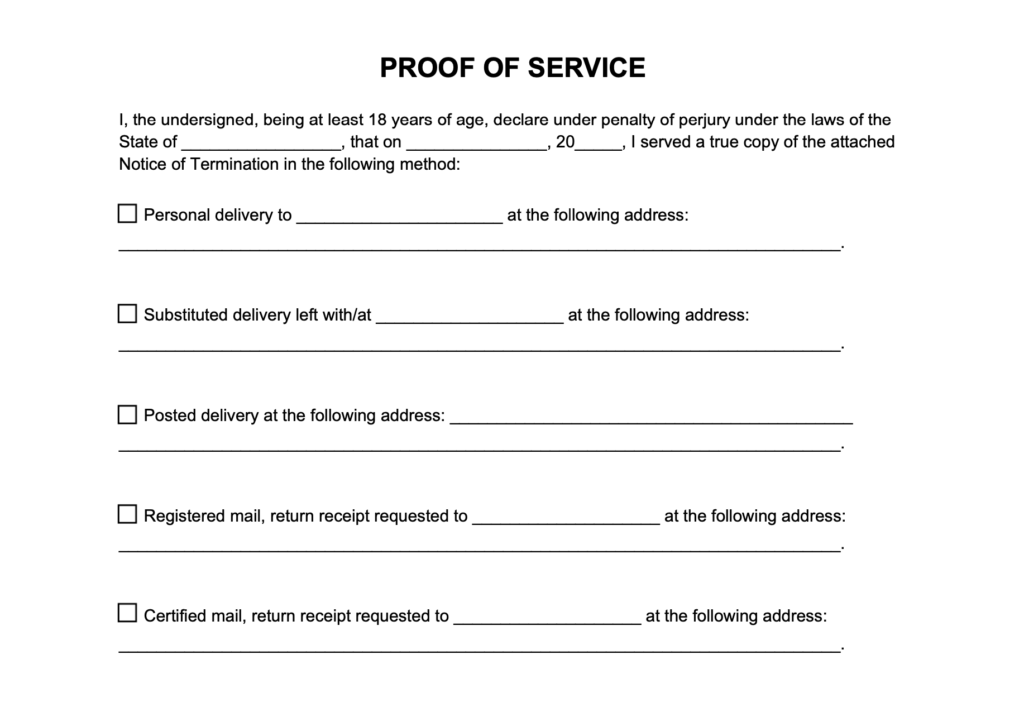
Step 6 – Sign the Notice
15. Person Delivering Notice. The server, the person delivering the eviction notice/notice of termination, signs and dates the proof of service and prints the full name.

Frequently Asked Questions
How long does it take to evict someone?
It usually takes 1 to 3 months to evict someone. The length of the eviction process depends on state laws — some states only require landlords to send a 3-day notice to quit, but others need 30 or more days’ notice.
Where do I find the name of my rental agreement so I can reference it in the eviction notice?
Your lease or rental agreement should have the title or name of the document at the top. Common names are Lease Agreement, Rental Agreement, or Residential Lease Agreement.
How many lease violations should landlords tolerate before evicting a tenant?
This depends on the severity of the lease violation. It is wise to evict the tenant as soon as possible for serious lease violations, such as significant damage to the property or criminal activity on the property.
However, with fewer lease violations, evicting is more critical after a pattern has formed. Any tenant might have a rough month in which they pay rent a few days late.
However, evicting a tenant is likely the best choice if they pay the rent late every month or their rent remains delinquent past the point of late fees.
Is giving a 3-day eviction notice legal?
It is legal for landlords to give a 3-day eviction notice. Still, the number of days depends on your particular state regulations, which require landlords to give tenants a certain amount of notice before evicting them.
For instance, a 3-day eviction notice in Florida is legal, while in New York, the minimum eviction notice is seven days. The number of days can vary depending on the reason for eviction and the type of property from which the tenant is being evicted.
In some states, the minimum notice can be as long as a month or more.
Is providing more than the minimum eviction notice legal?
The minimum eviction notice is the minimum amount of time a landlord must give their tenant to fix the lease violation (if applicable) or move out.
If the landlord gives the tenant more time to vacate the premises, they are legally free to do so.
Because the landlord cannot list the property again until the tenant has moved, there are disadvantages to giving more than the minimum eviction notice.
However, it can potentially be a way to ensure the tenant can securely vacate the premises and show good faith.
Landlords who maintain or wish to maintain good relationships with their tenants may offer a longer time to vacate the premises that goes beyond the minimum eviction notice.
The only legal boundary concerning the time in an eviction notice is that you must provide your tenants with at least the minimum eviction notice in your state.
Consider your tenants may also attempt to contest the eviction, which could lengthen the process. Ensure that your eviction notice adheres to all state and local statutes before serving it to your tenant.
